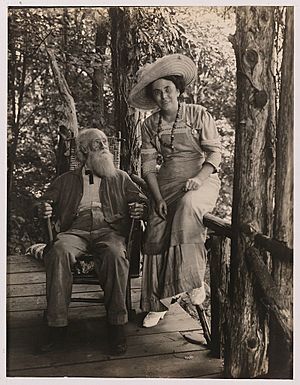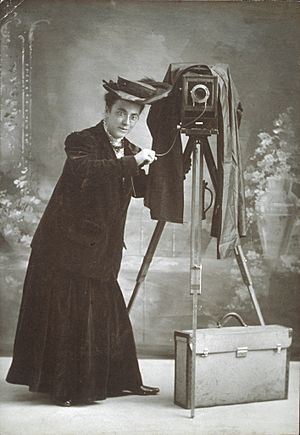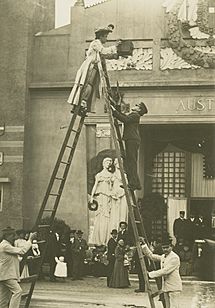Jessie Tarbox Beals facts for kids

Jessie Tarbox Beals (born December 23, 1870 – died May 30, 1942) was a famous American photographer. She was the first woman in the United States to have her photos published as a photojournalist. She was also a pioneer in taking pictures at night.
Jessie was well-known for her news photos, especially from the 1904 St. Louis World's Fair. She also took many portraits of places like Greenwich Village in New York City.
People remembered her for her strong drive and her ability to overcome challenges. She worked hard to succeed in a job that was mostly done by men.
Contents
Early Life and Learning Photography
Jessie Richmond Tarbox was born on December 23, 1870, in Hamilton, Canada. She was the youngest child of John Nathaniel Tarbox and Marie Antoinette Bassett.
Jessie was a very smart and quick-thinking child. She did very well in school. At age fourteen, she was accepted into the Collegiate Institute of Ontario. By age seventeen, she had earned her teaching certificate.
Jessie started teaching in a small, one-room schoolhouse in Williamsburg, Massachusetts. In 1888, she won a simple camera from a magazine contest. She began using it to photograph her students and the world around her. Soon, Jessie bought a better Kodak camera. She even set up Williamsburg's first photography studio in front of her house. At this time, photography was mostly her favorite hobby.
Sparking a Photography Career
In 1893, Jessie took a new teaching job in Greenfield, Massachusetts. She also visited the World's Columbian Exposition in Chicago. At this big event, Jessie met two famous photographers, Frances Benjamin Johnston and Gertrude Käsebier. Meeting them made her even more interested in travel and photography.
In 1897, Jessie married Alfred Tennyson Beals. He was a factory machinist.
Becoming a Photojournalist
In 1899, Jessie got her first professional photography job. The Boston Post newspaper asked her to photograph the Massachusetts state prison. Jessie taught Alfred how to help her with photography. In 1900, they started working together as traveling photographers. Alfred helped Jessie in the darkroom. That year, Jessie also got her first photo credit in a publication called the Windham County Reformer.
By 1901, Jessie and Alfred moved to Buffalo, New York. Later that year, Jessie was hired as a staff photographer for two newspapers, the Buffalo Inquirer and The Buffalo Courier. She impressed the editor with a photo of ducks called "On to Albany." This job made her the first female photojournalist in the United States. She worked for these papers until 1904.
Photojournalism was hard work and sometimes risky. Jessie would carry her large 8-by-10-inch glass plate camera and 50 pounds of equipment. She did all this while wearing her long dresses and big hats!
In 1904, Jessie was sent to cover the opening of the Louisiana Purchase Exposition in St. Louis, Missouri. She was very determined to get the best photos. She climbed ladders and even jumped into a hot air balloon! She was especially interested in photographing Indigenous peoples, capturing many natural moments.
Jessie had a unique style compared to other news photographers. She focused on taking many pictures that could later be used to tell a story. Her hard work earned her the job of official Fair photographer for several major newspapers. She took over 3,500 photographs and made 45,000 prints from the event.
At the Fair, Jessie also took a natural photo of President Theodore Roosevelt. This meeting led to her getting a special pass to photograph Roosevelt and the Rough Riders in San Antonio, Texas, in 1905.
Opening Her Own Studios
In 1905, Jessie opened her own photography studio on Sixth Avenue in New York City. She continued to take many different types of photos. These included pictures of car races, portraits of important people, and her famous photos of Greenwich Village. She also photographed several presidents and celebrities. These included presidents Coolidge, Hoover, and Taft. She also photographed famous writers like Mark Twain and Emily Post.
In 1911, Jessie had a daughter named Nanette Tarbox Beals. Jessie later left her husband in 1917.
In 1920, she moved to Greenwich Village and opened a new photography studio and gallery. For a few years, Jessie balanced her work with caring for Nanette. Nanette was often in the hospital, so Jessie decided to send her to camps and boarding schools. Nanette later lived with one of Jessie's old friends.
Later Years and Legacy
As more women became photographers in the 1920s, Jessie changed her focus. She started giving public talks and specializing in photographing gardens and large homes. These were often owned by wealthy people on the East Coast.
By 1928, Jessie and Nanette moved to California. There, Jessie photographed Hollywood estates. The Great Depression brought them back to New York in 1933. Jessie lived and worked in Greenwich Village again.
Jessie gradually became poor. Years of spending and the effects of the Depression took a toll. She passed away on May 30, 1942, at Bellevue Hospital. She was seventy-one years old.
Her photographs and prints are now kept in important collections. These include the Library of Congress, Harvard University, the New-York Historical Society, and the American Museum of Natural History. In 1982, her daughter, Nanette Beals Brainerd, gave Jessie's papers and pictures to the Schlesinger Library at Radcliffe.
Images for kids
-
Jessie Tarbox Beals with John Burroughs, 1908
See also
 In Spanish: Jessie Tarbox Beals para niños
In Spanish: Jessie Tarbox Beals para niños






